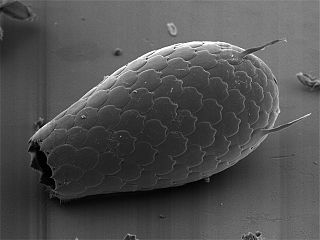
A flagellate is a cell or organism with one or more whip-like appendages called flagella. The word flagellate also describes a particular construction characteristic of many prokaryotes and eukaryotes and their means of motion. The term presently does not imply any specific relationship or classification of the organisms that possess flagella. However, several derivations of the term "flagellate" are more formally characterized.

Cercozoa is a phylum of diverse single-celled eukaryotes. They lack shared morphological characteristics at the microscopic level, and are instead united by molecular phylogenies of rRNA and actin or polyubiquitin. They were the first major eukaryotic group to be recognized mainly through molecular phylogenies. They are the natural predators of many species of bacteria. They are closely related to the phylum Retaria, comprising amoeboids that usually have complex shells, and together form a supergroup called Rhizaria.

Cercomonads are small amoeboflagellates, widespread in aqueous habitats and common in soils.

Monadofilosa is a grouping of Cercozoa. These organisms are single-celled amoeboid protists.

Telonemia is a phylum of microscopic eukaryotes commonly known as telonemids. They are unicellular free-living flagellates with a unique combination of cell structures, including a highly complex cytoskeleton unseen in other eukaryotes.

Thecofilosea is a class of unicellular testate amoebae belonging to the phylum Cercozoa. They are amoeboflagellates, organisms with flagella and pseudopodia, distinguished from other cercozoa by their scale-lacking test composed of organic material. They are closely related to the Imbricatea, a group of testate amoebae with tests composed of inorganic silica scales.

The sarcomonads or class Sarcomonadea are a group of amoeboid biciliate protists in the phylum Cercozoa. They are characterized by a propensity to move through gliding on their posterior cilium or through filopodia, a lack of scales or external theca, a soft cell surface without obvious cortical filamentous or membranous skeleton, two cilia without scales or hairs, tubular mitochondrial cristae, near-spherical extrusomes, and a microbody attached to the nucleus.
Platysulcus tardus is an eukaryotic microorganism that was recently discovered to be the earliest diverging lineage of the Heterokont phylogenetic tree. It is the only member of the family Platysulcidae, order Platysulcida and class Platysulcea.
Neocercomonas is a protist genus of the order Cercomonadida. It consists of single-celled bacteriophagous organisms that usually live on or nearby terrestrial plants, both above and belowground. Species are biflagellate and may grow up to 60 micrometers long, with a trailing tail-like mass of protoplasm at their posterior end and a pair of roots connecting their posterior flagellum to the cytoskeleton.
The paracercomonads are a group of cercozoan protists. Taxonomically, they comprise the family Paracercomonadidae, order Paracercomonadida and subclass Paracercomonada. Due to their morphological similarities to the cercomonads, members of this family were grouped with Cercomonas and similar taxa from the beginning. However, their similarities are due to convergent evolution.

Ventrifilosa is a highly diverse group of phagotrophic protists that glide through their flagella and emit filose pseudopods from their ventral side for feeding. Because of their mixture of amoeba and flagellate characteristics, they are amoeboflagellates. Members of this group are the Imbricatea, Sarcomonadea and Thecofilosea.
Mesofila is a genus of freshwater heterotrophic protists of the phylum Cercozoa. It is the only genus in the family Mesofilidae. It is a monotypic genus, with the sole species M. limnetica.
Minimassisteria is a marine bacterivorous genus of protists with only one species, M. diva, that presents three different lifestyle forms. It has a widespread geographic distribution. It is an amoeboflagellate most closely related to Massisteria, and together comprise the family Massisteriidae.

The glissomonads are a group of bacterivorous gliding flagellated protists that compose the order Glissomonadida, in the amoeboflagellate phylum Cercozoa. They comprise a vast, largely undescribed diversity of soil and freshwater organisms. They are the sister group to cercomonads; the two orders form a solid clade of gliding soil-dwelling flagellates called Pediglissa.
Pediglissa is a subclass of phagotrophic protists that inhabit soil or freshwater habitats. They were defined in 2018 according to phylogenetic analyses that showed a clade containing the orders Cercomonadida and Glissomonadida. They're the sister group of Paracercomonadida.

Viridiraptoridae, previously known as clade X, is a clade of heterotrophic protists in the phylum Cercozoa. They're a family of glissomonads, a group containing a vast, mostly undescribed diversity of soil and freshwater organisms.

Orciraptor is a genus of heterotrophic protists, containing the single species Orciraptor agilis. It belongs to the family Viridiraptoridae, in the phylum Cercozoa.
Aurigamonas is a genus of predatory protists of an unusual cell structure, with two flagella and numerous haptopodia. It is a monotypic genus containing the single species Aurigamonas solis. It is the only genus of the family Aurigamonadidae.
Helkesida is a group of microscopic protists belonging to the supergroup Rhizaria, both discovered through molecular phylogenetic analyses. It contains amoeboid flagellates with two flagella. They are either free-living, mostly on fecal matter, or live inside the gut of animals. Among these amoebae, one lineage has independently evolved aggregative multicellularity similarly to slime moulds.

An amoeboflagellate is any eukaryotic organism capable of behaving as an amoeba and as a flagellate at some point during their life cycle. Amoeboflagellates present both pseudopodia and at least one flagellum, often simultaneously.








